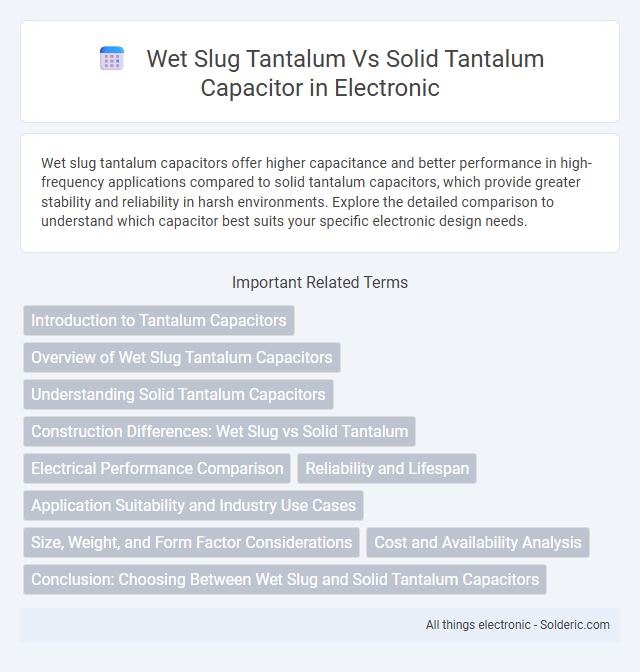Wet slug tantalum capacitors offer higher capacitance and better performance in high-frequency applications compared to solid tantalum capacitors, which provide greater stability and reliability in harsh environments. Explore the detailed comparison to understand which capacitor best suits your specific electronic design needs.
Comparison Table
| Feature | Wet Slug Tantalum Capacitor | Solid Tantalum Capacitor |
|---|---|---|
| Electrolyte Type | Liquid (Wet Electrolyte) | Solid Manganese Dioxide or Polymer |
| Capacitance Range | Up to Several Thousands uF | Typically up to a Few Thousand uF |
| Voltage Range | Higher Voltage Ratings (Up to 125 V or More) | Lower Voltage Ratings (Typically Up to 50 V) |
| ESR (Equivalent Series Resistance) | Lower ESR due to liquid electrolyte | Higher ESR compared to wet slug |
| Reliability | Generally More Reliable in High Voltage Applications | Less Reliable at High Voltages, More Sensitive to Surge Currents |
| Size | Larger due to Wet Electrolyte Design | Smaller and Compact |
| Cost | Higher Cost | Lower Cost |
| Typical Applications | Military, Aerospace, High Voltage Power Supplies | Consumer Electronics, Telecommunications, General Purpose |
Introduction to Tantalum Capacitors
Tantalum capacitors, available as wet slug and solid types, are renowned for their high capacitance per volume and stable electrical characteristics. Wet slug tantalum capacitors use liquid electrolyte, offering higher ripple current capacity and improved performance under high humidity conditions compared to solid tantalum capacitors, which utilize a solid manganese dioxide or conductive polymer electrolyte. These differences impact reliability, ESR values, and application suitability in power supply filtering and decoupling circuits within aerospace, medical, and industrial electronics.
Overview of Wet Slug Tantalum Capacitors
Wet slug tantalum capacitors utilize a tantalum anode combined with a liquid electrolyte, offering superior performance in high-voltage and high-temperature applications compared to solid tantalum capacitors. The liquid electrolyte ensures better self-healing properties and higher capacitance stability under stress, making them ideal for military and aerospace electronics. Their construction allows for improved surge current tolerance and enhanced reliability in extreme environmental conditions.
Understanding Solid Tantalum Capacitors
Solid tantalum capacitors feature a compact anode made from sintered tantalum powder, providing superior reliability and stable electrical characteristics across various temperatures. These capacitors exhibit low Equivalent Series Resistance (ESR) and excellent frequency response, making them ideal for high-performance applications requiring durability and long lifespan. Compared to wet slug tantalum capacitors, solid tantalum types have better mechanical robustness and are less prone to leakage, enhancing their suitability for demanding electronic circuits.
Construction Differences: Wet Slug vs Solid Tantalum
Wet slug tantalum capacitors feature a tantalum slug immersed in an electrolyte, providing improved thermal conductivity and surge current capability compared to solid tantalum capacitors. Solid tantalum capacitors use a sintered tantalum powder anode with a solid manganese dioxide or polymer cathode, resulting in a compact and stable structure but with lower surge current tolerance. The distinct construction differences impact performance, reliability, and application suitability, with wet slug capacitors favored for high-power and high-temperature environments.
Electrical Performance Comparison
Wet slug tantalum capacitors exhibit superior electrical performance with higher capacitance values and lower equivalent series resistance (ESR) compared to solid tantalum capacitors, enabling better efficiency in high-frequency applications. Solid tantalum capacitors, while more compact and reliable under steady-state conditions, tend to have higher ESR and lower ripple current tolerance, limiting their use in demanding power electronics. The wet slug design also offers enhanced thermal stability and longer lifespan in harsh environments, making it preferable for critical aerospace and military applications.
Reliability and Lifespan
Wet slug tantalum capacitors offer superior reliability due to their inherent self-healing properties and resistance to thermal and mechanical stress, resulting in a longer lifespan compared to solid tantalum capacitors. Solid tantalum capacitors, while compact and cost-effective, are more prone to failure under surge currents and voltage spikes, which can shorten their operational life. Choosing wet slug tantalum capacitors for Your applications can enhance overall system reliability and reduce maintenance costs over time.
Application Suitability and Industry Use Cases
Wet slug tantalum capacitors offer high capacitance and low ESR, making them ideal for power supply filtering and audio applications in aerospace and military sectors where reliability under extreme conditions is critical. Solid tantalum capacitors excel in compact electronic devices, automotive systems, and medical equipment due to their stability, smaller size, and long-term performance in low-voltage circuits. Your selection depends on specific application needs, balancing size constraints, operating environment, and required capacitance values.
Size, Weight, and Form Factor Considerations
Wet slug tantalum capacitors generally offer higher volumetric efficiency, resulting in smaller size and lighter weight compared to solid tantalum capacitors with equivalent capacitance. Solid tantalum capacitors tend to have a more compact form factor suitable for high-reliability applications, but they may weigh more due to their dense internal structure. Your choice should consider the trade-offs between size constraints and durability requirements in the intended electronic design.
Cost and Availability Analysis
Wet slug tantalum capacitors generally incur higher manufacturing costs due to their complex construction and require stringent quality control, making them less economically feasible for large-scale production. Solid tantalum capacitors benefit from widespread adoption and simplified manufacturing processes, resulting in lower costs and greater availability across various markets. Market supply for solid tantalum capacitors remains robust, driven by high demand in consumer electronics, whereas wet slug variants are more niche with limited suppliers and reduced inventory levels.
Conclusion: Choosing Between Wet Slug and Solid Tantalum Capacitors
Wet slug tantalum capacitors provide higher ripple current ratings and superior surge handling, making them ideal for power supply filtering in high-reliability applications. Solid tantalum capacitors offer smaller size and better volumetric efficiency, preferred in compact electronic devices requiring stable capacitance and low ESR. Selecting between wet slug and solid tantalum capacitors depends on balancing performance needs such as current capability, size constraints, and environmental reliability requirements.
Wet slug tantalum vs solid tantalum capacitor Infographic

 solderic.com
solderic.com